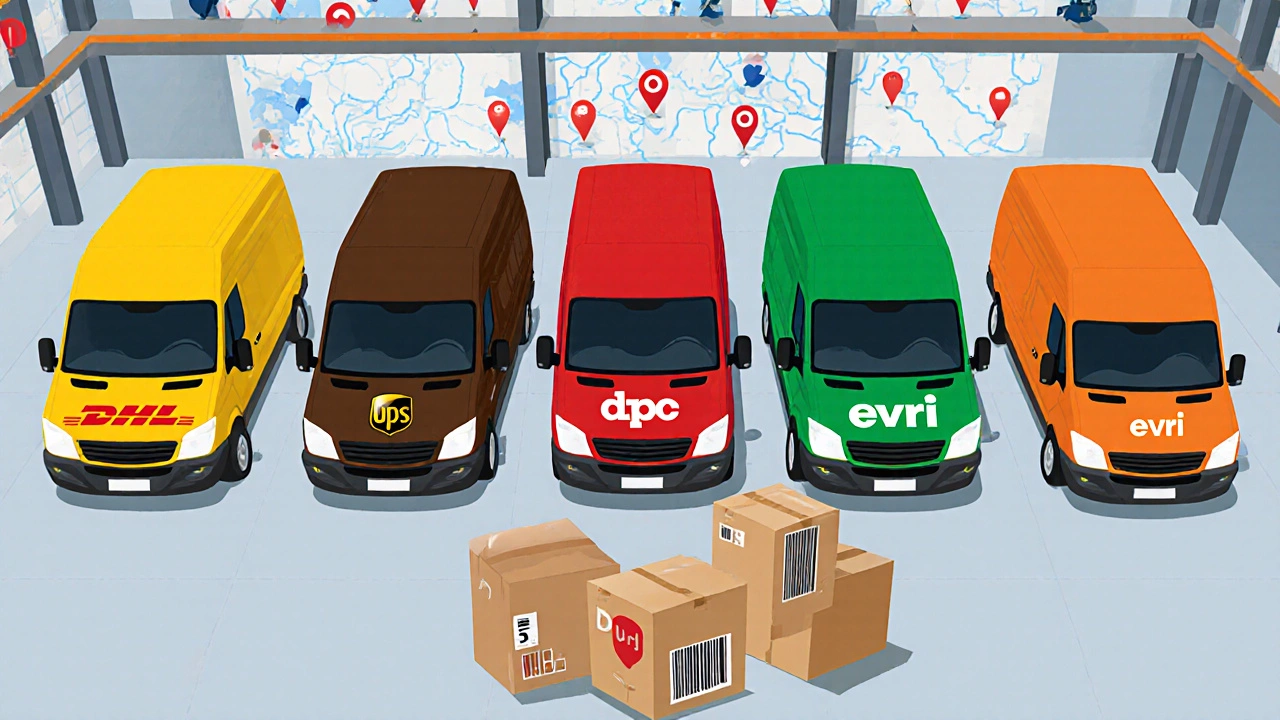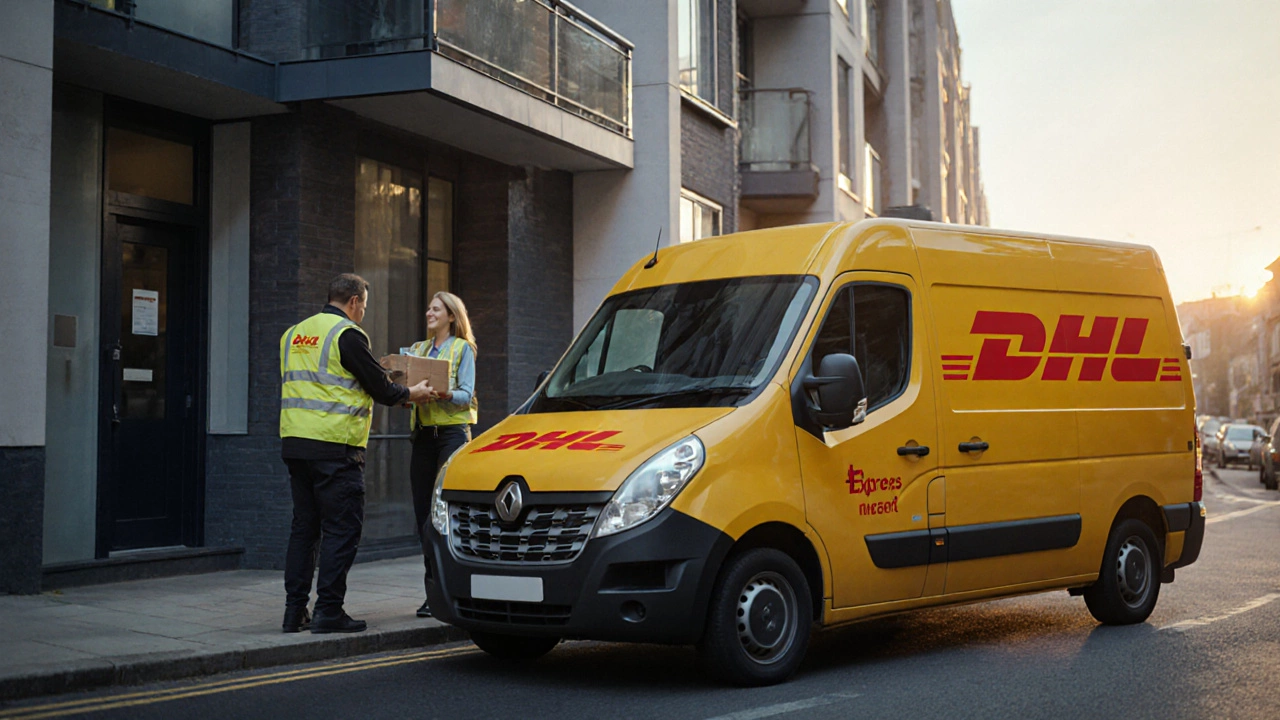Next-Day Delivery Carrier Calculator
Calculate Your Next-Day Delivery Costs
Carrier Comparison
Recommended Carrier
Select your parcel weight and service requirements to see the best carrier for your business.
Key Takeaways
- Three UK carriers consistently hit sub‑95% on‑time rates for next‑day delivery: DHL Express, UPS, and ParcelForce.
- Average base price for a 5kg parcel ranges from £7.90 (DPD) to £12.50 (UPS).
- Real‑time tracking, Saturday drop‑off, and cash‑on‑delivery add cost but boost customer satisfaction.
- Small e‑commerce shops benefit from flat‑rate contracts, while large retailers gain from volume discounts.
- Avoid hidden fees by checking fuel surcharge policies and address‑type surcharges.
When a customer expects their order on the next calendar day, the difference between a happy shopper and a lost sale often comes down to the carrier you choose. In the UK, several couriers promise next‑day delivery, but not all deliver the same speed, reliability, or value. This guide breaks down the most important criteria, compares the top players, and gives you a clear roadmap to pick the best carrier for next day delivery for your business.
Job 1: Define What "Next‑Day Delivery" Actually Means
Before you start hunting for quotes, you need a concrete definition. In the UK market, "next‑day delivery" typically means:
- Parcel is dispatched the same business day it is received.
- Delivery is completed before the end of the next business day (often by 9pm).
- Service is guaranteed with a refund or re‑delivery if the deadline is missed.
Most carriers differentiate between "Standard Next‑Day" (Monday‑Friday) and "Next‑Day Plus" (Saturday delivery). Knowing which version you need shapes the cost and carrier choice.
Job 2: Evaluate the Core Selection Criteria
Every retailer should score each carrier against the same checklist. The most decisive factors in 2025 are:
- On‑time performance: Industry reports from ARC and Trustpilot show average on‑time percentages.
- Coverage area: Nationwide reach vs. limited regional hubs.
- Base pricing: Flat‑rate vs. weight‑based pricing for common parcel sizes.
- Tracking fidelity: Real‑time updates, predictive ETA, and API access.
- Additional services: Saturday drop‑off, cash‑on‑delivery (COD), signature proof.
- Contract flexibility: Volume‑based discounts, short‑term contracts for seasonal spikes.
Below we apply this matrix to the most widely used UK carriers.

Job 3: Meet the Top Five UK Carriers Offering Guaranteed Next‑Day Delivery
Each carrier description includes the first‑time microdata markup, so search engines can pull out clear entity data.
When speed matters, DHL Express is a global courier known for its extensive network and guaranteed next‑day delivery across the UK and Europe. DHL’s average on‑time rate sits at 96.2% for parcels under 10kg, and its flat‑rate for a 5kg box is £11.90. The service includes end‑to‑end tracking, Saturday delivery for an extra £2.50, and a 30‑day money‑back guarantee if the deadline is missed.
UPS offers a robust UK‑focused next‑day service called UPS Express Saver, which guarantees delivery by 9pm the following day. UPS scores 95.8% on‑time performance and charges £12.50 for a 5kg parcel. Their tracking API is praised by larger e‑commerce platforms for near‑real‑time updates, and they provide optional COD at £1.20 per transaction.
For businesses looking for a UK‑centric provider, ParcelForce (the parcel arm of Royal Mail) delivers next‑day service to 99% of UK postcodes, with a focus on residential addresses. Their on‑time record is 94.5%, and a 5kg parcel costs £9.80. ParcelForce shines with its extensive local depot network, enabling Saturday deliveries without extra fees for most zones.
DPD provides a Predict service that guarantees next‑day delivery to most urban and suburban areas, backed by predictive ETA notifications. DPD’s on‑time rate is 93.7%, and the base price for a 5kg parcel is £7.90 - the most affordable among the five. However, DPD’s coverage excludes remote islands, and Saturday drops are billed at £1.80 per parcel.
Evri (formerly Hermes) runs a next‑day service aimed at low‑cost e‑commerce shipments, with a focus on bulk‑weight discounts. Evri’s on‑time performance is 91.2%, and it costs £8.60 for a 5kg parcel. The carrier offers free Saturday delivery for orders over £30 in value, but its tracking granularity is limited to "in‑transit" and "delivered" statuses.
Job 4: Compare the Carriers Side‑by‑Side
| Carrier | On‑Time % | Base Price (5kg) | Nationwide Coverage | Saturday Delivery | COD Fee | API Access |
|---|---|---|---|---|---|---|
| DHL Express | 96.2 | £11.90 | All postcodes | £2.50 extra | £1.00 | Full REST API |
| UPS | 95.8 | £12.50 | All postcodes | £2.00 extra | £1.20 | Full REST API |
| ParcelForce | 94.5 | £9.80 | 99% postcodes | Free | £1.30 | XML & JSON |
| DPD | 93.7 | £7.90 | 95% postcodes | £1.80 extra | £1.00 | REST API |
| Evri | 91.2 | £8.60 | 92% postcodes | Free (orders >£30) | £0.90 | Basic JSON |
Reading the table, a clear pattern emerges: the higher‑priced carriers (DHL, UPS) win on reliability and API depth, while DPD and Evri win on cost but lag in coverage and tracking detail. Your choice should mirror the trade‑off that matters most to your customers.
Job 5: Choose the Right Carrier for Your Business Model
Below are three typical e‑commerce scenarios and the carrier that fits best.
- High‑value tech accessories: Customers expect flawless delivery and can pay a premium. DHL Express offers the highest on‑time guarantee and a robust API that integrates with most order‑management systems.
- Fast‑fashion retailer with 10,000 orders per month: Volume discounts matter. UPS and ParcelForce both provide tiered pricing for high volumes; ParcelForce’s free Saturday delivery can be a marketing hook.
- Small boutique selling handmade goods: Keeping shipping cheap is essential. DPD’s lower base price and predictive ETA alerts work well for < 500 parcels per month.
Don’t forget to renegotiate contracts annually. Many carriers reset pricing every 12months, and a modest 3‑5% discount is often achievable with a clear volume forecast.
Job 6: Practical Tips to Maximize Next‑Day Success
Even the best carrier can stumble if you don’t prep shipments correctly. Follow these proven steps:
- Cut‑off awareness: Mark the same‑day cut‑off time (usually 2pm) on your order confirmation page so customers know the deadline for next‑day eligibility.
- Standardize packaging: Use carrier‑approved box sizes (e.g., DHL’s 30×30×30cm for <5kg) to avoid surcharges.
- Barcode accuracy: Print high‑resolution barcodes and place them on the flat side of the parcel; mis‑reads cause delays.
- Address validation: Run postcodes through Royal Mail’s PAF database to catch typos before hand‑over.
- API integration: Push order data to the carrier’s endpoint within 5minutes of payment to trigger same‑day pickup.
- Monitor performance: Pull daily on‑time reports and set alerts if a carrier’s rate falls below 93%.
Job 7: Common Pitfalls and How to Avoid Them
Here are the three biggest mistakes e‑commerce sites make with next‑day shipping and the quick fix.
- Ignoring fuel surcharges: Many carriers add a %‑based fuel fee that spikes in winter. Include a 5‑10% buffer in your shipping calculator.
- Choosing the cheapest carrier without checking address coverage: Sending to a remote Scottish island with DPD will default to two‑day service and upset the buyer. Verify postcode eligibility before confirming the shipping method.
- Not updating COD fees: COD can be a profit driver, but each carrier’s per‑transaction fee changes quarterly. Set up an automated feed to keep your checkout totals accurate.
Quick Checklist Before You Commit
- Identify your average parcel weight and volume.
- Map your top 20% of customers by postcode to check coverage.
- Run a 30‑day cost simulation using each carrier’s price table.
- Test API connectivity with a sandbox order.
- Negotiate a trial contract with a 15‑day performance clause.
By following this roadmap, you’ll be able to pick a carrier that not only meets the promised next‑day deadline but also aligns with your cost structure and customer expectations.
Frequently Asked Questions
What is the typical cut‑off time for next‑day delivery in the UK?
Most major carriers require parcels to be handed over by 2pm local time on the day of dispatch. Some premium services (e.g., DHL Express) offer a 4pm cut‑off in major cities, but it’s safest to assume a 2pm deadline for nationwide coverage.
Can I get a guaranteed next‑day delivery to remote islands like the Isle of Wight?
Guarantees vary. UPS and DHL cover 100% of UK postcodes, including the Isle of Wight, but they often add a surcharge. DPD and Evri may reroute to two‑day service for such locations, so check the carrier’s postcode coverage matrix before promising the service.
How much does a typical Saturday next‑day delivery cost?
Saturday delivery adds between £1.80 and £2.50 per parcel, depending on the carrier. DHL and UPS charge a flat £2.00‑£2.50, while ParcelForce includes Saturday drop‑off at no extra charge for most zones.
Is real‑time tracking essential for next‑day shipments?
Yes. Customers expect to see the parcel’s exact location and an ETA. Carriers like DHL, UPS, and ParcelForce provide minute‑by‑minute updates via robust APIs. Lower‑cost options like Evri only show "in‑transit" and "delivered" stages, which can increase support tickets.
Can I mix carriers for different regions to save money?
Absolutely. Many retailers use UPS for high‑value electronics nationwide and switch to DPD for low‑margin fashion items in urban areas. The key is a unified order‑management system that routes each order to the optimal carrier based on weight, destination, and service level.


